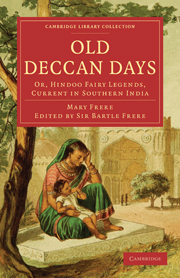Book contents
- Frontmatter
- LIST OF THE COLOURED ILLUSTRATIONS
- Contents
- INTRODUCTION
- THE COLLECTOR'S APOLOGY
- THE NARRATOR'S NARRATIVE
- 1 PUNCHKIN
- 2 A FUNNY STORY
- 3 BRAVE SEVENTEE-BAI
- 4 TRUTH'S TRIUMPH
- 5 RAMA AND LUXMAN; OR, THE LEARNED OWL
- 6 LITTLE SURYA-BAI
- 7 THE WANDERINGS OF VICRAM MAHARAJAH
- 8 LESS INEQUALITY THAN MEN DEEM
- 9 PANCH-PHUL RANEE
- 10 HOW THE SUN, THE MOON, AND THE WIND WENT OUT TO DINNER
- 11 SINGH-RAJAH, AND THE CUNNING LITTLE JACKALS
- 12 THE JACKAL, THE BARBER, AND THE BRAHMIN WHO HAD SEVEN DAUGHTERS
- 13 TIT FOR TAT
- 14 THE BRAHMIN, THE TIGER, AND THE SIX JUDGES
- 15 THE SELFISH SPARROW AND THE HOUSELESS CROWS
- 16 THE VALIANT CHATTEE-MAKER
- 17 THE RAKSHAS' PALACE
- 18 THE BLIND MAN, THE DEAF MAN, AND THE DONKEY
- 19 MUCHIE-LAL
- 20 CHUNDUN-RAJAH
- 21 SODEWA-BAI
- 22 CHANDRA'S VENGEANCE
- 23 HOW THE THREE CLEVER MEN OUTWITTED THE DEMONS
- 24 THE ALLIGATOR AND THE JACKAL
- NOTES
- Plate section
INTRODUCTION
Published online by Cambridge University Press: 05 November 2011
- Frontmatter
- LIST OF THE COLOURED ILLUSTRATIONS
- Contents
- INTRODUCTION
- THE COLLECTOR'S APOLOGY
- THE NARRATOR'S NARRATIVE
- 1 PUNCHKIN
- 2 A FUNNY STORY
- 3 BRAVE SEVENTEE-BAI
- 4 TRUTH'S TRIUMPH
- 5 RAMA AND LUXMAN; OR, THE LEARNED OWL
- 6 LITTLE SURYA-BAI
- 7 THE WANDERINGS OF VICRAM MAHARAJAH
- 8 LESS INEQUALITY THAN MEN DEEM
- 9 PANCH-PHUL RANEE
- 10 HOW THE SUN, THE MOON, AND THE WIND WENT OUT TO DINNER
- 11 SINGH-RAJAH, AND THE CUNNING LITTLE JACKALS
- 12 THE JACKAL, THE BARBER, AND THE BRAHMIN WHO HAD SEVEN DAUGHTERS
- 13 TIT FOR TAT
- 14 THE BRAHMIN, THE TIGER, AND THE SIX JUDGES
- 15 THE SELFISH SPARROW AND THE HOUSELESS CROWS
- 16 THE VALIANT CHATTEE-MAKER
- 17 THE RAKSHAS' PALACE
- 18 THE BLIND MAN, THE DEAF MAN, AND THE DONKEY
- 19 MUCHIE-LAL
- 20 CHUNDUN-RAJAH
- 21 SODEWA-BAI
- 22 CHANDRA'S VENGEANCE
- 23 HOW THE THREE CLEVER MEN OUTWITTED THE DEMONS
- 24 THE ALLIGATOR AND THE JACKAL
- NOTES
- Plate section
Summary
A few words seem necessary regarding the origin of these stories, in addition to what the Narrator says for herself in her Narrative, and what is stated in the Collector's “Apology.”
With the exception of two or three, which will be recognised as substantially identical with stories of Pilpay or other well-known Hindoo fabulists, I never before heard any of these tales among the Mahrattas, in that part of the Deccan where the Narrator and her family have lived for the last two generations; and it is probable that most of the stories were brought from among the Lingaets of Southern India, the tribe, or rather, sect, to which Anna de Souza tells us her family belonged before their conversion to Christianity.
The Lingaets form one of the most strongly marked divisions of the Hindoo races south of the river Kistna. They are generally a well-favoured, well-to-do people, noticeable for their superior frugality, intelligence, and industry, and for the way in which they combine and act together as a separate body apart from other Hindoos. They have many peculiarities of costume, of social ceremony, and of religion, which strike even a casual observer; and though clearly not aboriginal, they seem to have much ground for their claim to belong to a more ancient race, and an earlier wave of immigration, than most of the Hindoo nations with which they are now intermingled.
- Type
- Chapter
- Information
- Old Deccan DaysOr, Hindoo Fairy Legends, Current in Southern India, pp. vii - xvPublisher: Cambridge University PressPrint publication year: 2010First published in: 1868



